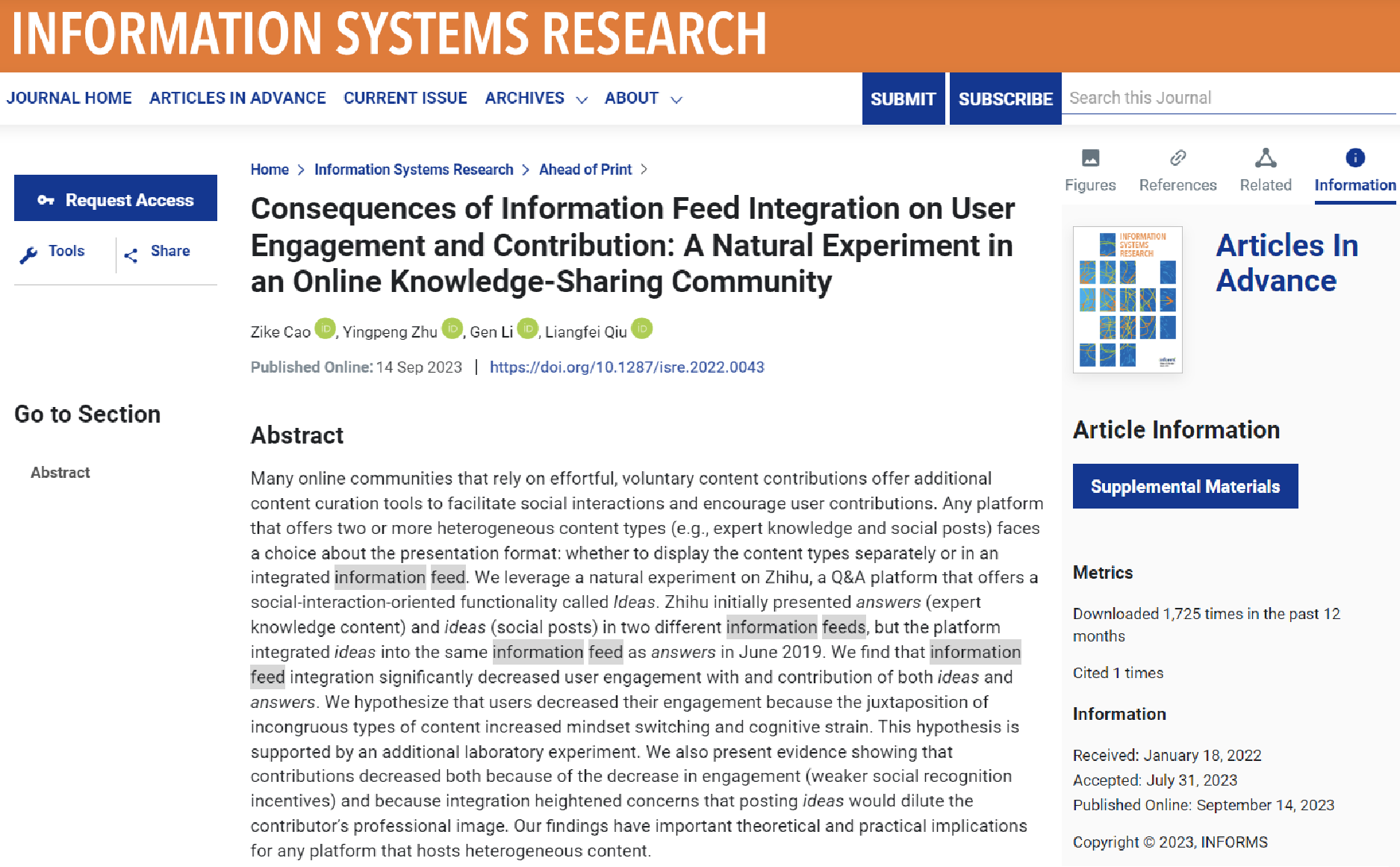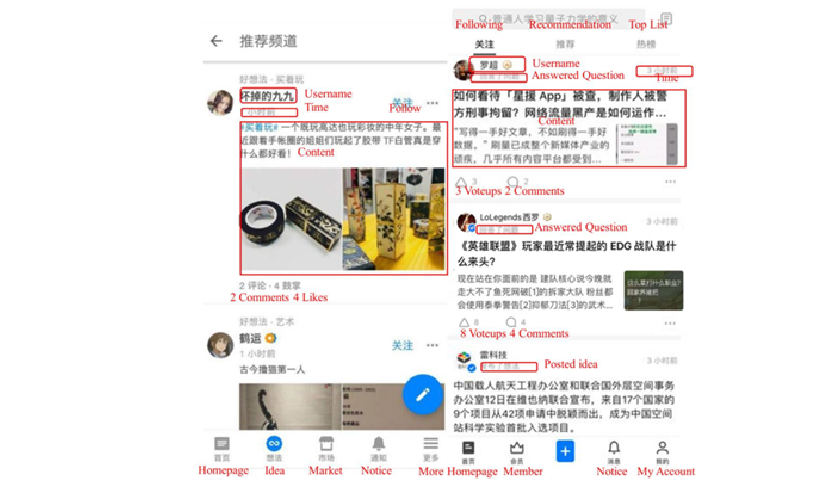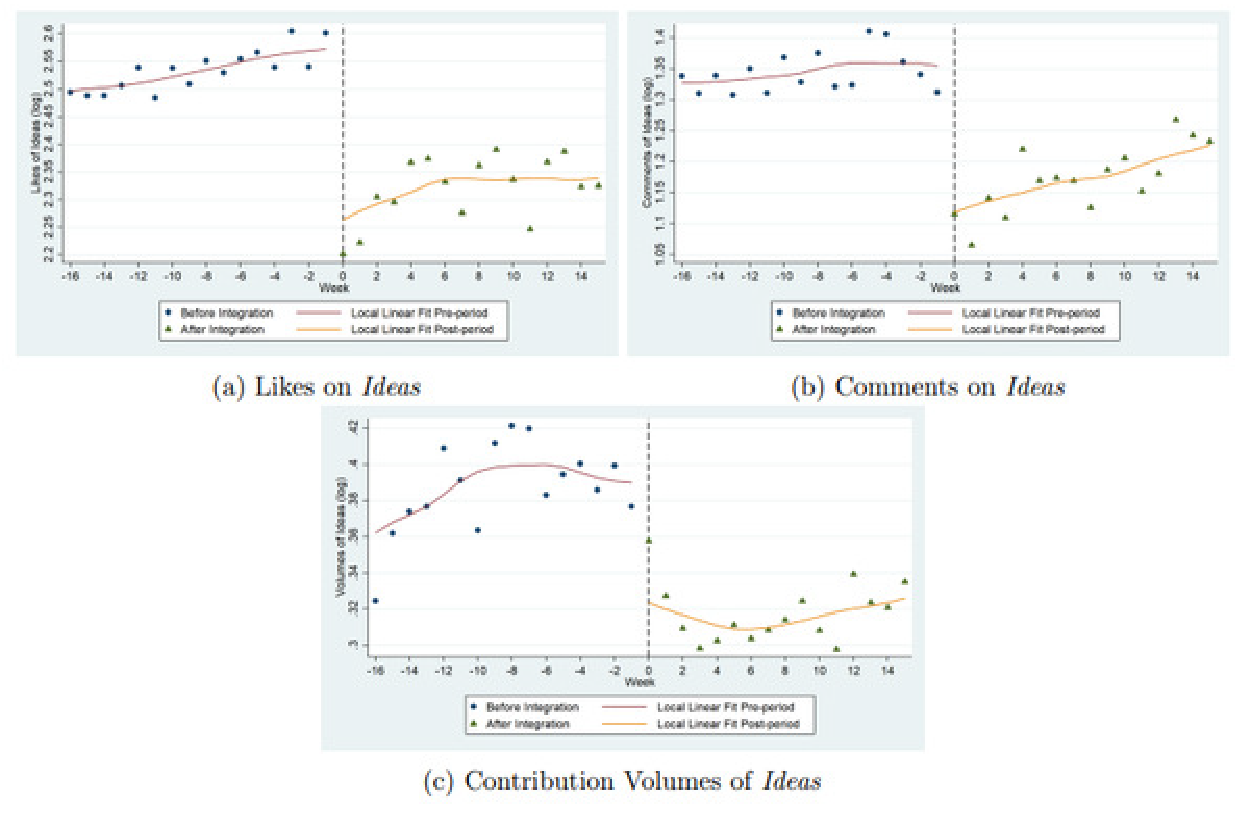
There are many content-sharing platforms around the world. In China, for example, just to name a few, anyone who frequently browses or creates content online certainly knows and uses such content-sharing platforms as Zhihu (知乎), Xiaohongshu (小红书), Sina Weibo (微博), WeChat Moments (微信), etc.
In order to reach and engage more people, many content platforms around the world today frequently make changes to the presentation of their content to increase user engagement and avoid user loss. The reason for this is that platforms’ developers and managers believe that integrating multiple content categories and presenting them in the same stream of information can satisfy users’ various needs and be more popular with users. However, the latest research results show exactly the opposite.
CAO Zike, a researcher at Zhejiang University School of Management, led a team to publish "Consequences of Information Feed Integration on User Engagement and Contribution: A Natural Experiment in an Online Knowledge-Sharing Community" in the top international journal Information Systems Research (ISR) (UTD 24 journal, FT50 journal). The article Sharing Community shows the negative effects of the "all-encompassing" information flow on the operation of online content platforms.

You can read the original paper here
|
CAO Zike | 曹仔科 School of Management, Zhejiang University |
||
|
|
||
|
|
|
Academic Background: Professor CAO Zike is a tenured associate professor of Information Systems at the School of Management of Zhejiang University. His research examines the impact of new information technologies on user behavior and the resulting implications for business practices and regulations in various online contexts, including e-commerce and social media. You can learn more about Prof. CAO Zike’s academic background here |
|
Researchers Conducted Empirical Studies and Discovered the Negative Effects of the Mixed-information Presentation Approach |
In the internet age, where the number of platforms is increasing day by day, competition between platforms for visitors has become extremely fierce. To increase user engagement, each major platform has its own strategies to serve users.
There are "inconsistencies" in the way content is presented on the different platforms
If we look at the major platforms in China, we see that some platforms that used to only share trivial content about daily life are now sharing professional and in-depth articles, such as Sina Weibo and WeChat Moments.
This is what platform managers have done to increase user engagement and reduce user churn - they have developed corresponding functions so that users can post different types of content on the same platform to suit their different purposes (e.g. socializing, sharing knowledge, etc.).
When it comes to the question "How should the different types of content collected on the same platform be presented in the users’ information flow", different platforms have different approaches.
This difference is mainly reflected in two ways of presenting content: on the one hand, the different types of content are presented through different information flows, and on the other hand, they are integrated and presented in the same information flow. So which presentation method is better?
Researchers compared the two presentation methods based on empirical studies
To find answers to the above questions, CAO Zike’s team compared these two presentation methods in their study and investigated the impact and inner mechanism of the different information flow design methods on platform users’ content consumption and production.
They focused on Zhihu (知乎), the largest Q&A knowledge platform in China, and conducted an innovative empirical investigation.
Zhihu was founded in 2011. In previous years, it mainly presented serious content and encouraged users to contribute expertise in the form of questions and answers.
By August 2017, Zhihu introduced a feature called "Ideas" to increase user engagement and activity". This feature is similar to Sina Weibo or WeChat Moments and allows users not to stick to the Q&A format but to publish content more freely on the Zhihu platform.
Therefore, users often use this function to publish leisure and entertainment content related to their daily lives.
It can be seen that in the nearly two years since the launch of the “Ideas” function, Zhihu has presented the content of “Ideas” to users in an independent information stream. But in June 2019, Zhihu integrated the "Ideas" content into the main information stream, i.e. mixing the "Ideas" content with serious knowledge content such as "Answers" and "Articles".

Figure 3 | Zhihu “Ideas” Integration: Before (left) and After (Right)
CAO Zike’s team investigated the effects of this information flow integration by collecting data on the content consumption and production behavior of "representative user groups" before and after the integration of Zhihu’s information flow.
Ultimately, their study found that the integration of casual content (“ideas”) and serious knowledge content (“answers” and “articles”) led to a significant decrease in the browsing and reading behavior of the platform’s users.
This is particularly reflected in the fact that the number of likes and comments for both types of content dropped significantly after the integration of the information flow.
|
Why is it easy to lose users when diversified content is presented in a mixed manner? |
It turns out that the mixed presentation of diversified content in the same information flow can easily have a negative impact on the development of the platform.
So why does the integration of casual content (“ideas") and serious knowledge content (“answers” and “Articles") lead to a significant decrease in browsing and reading of both types of content?
01 | "Frequent switching of thinking mode" makes reading more difficult
Based on the theory of thinking mode in psychology, CAO Zike’s team believes that the reason for this negative effect is that the integration of information flow causes different types of content to be mixed together and the user’s brain processes this information. This requires a frequent change of mindset, which undoubtedly makes the user’s brain work harder and causes the users to get tired of surfing and reading.
To confirm this point of view, they conducted a randomized, controlled experiment with two groups in which they mixed knowledge and entertainment content and presented it separately on two pages.
By measuring and comparing the subjects’ perceptions and behaviors during information processing under the two methods of information presentation, especially the frequency of switching thinking modes, we were finally able to provide direct evidence for this internal explanatory mechanism.
02 | Two main reasons reduce users’ willingness to create
In addition, CAO Zike’s team found in their research that the motivation of creative users of platforms to contribute casual content (“ideas”) and serious knowledge content (“answers” and “articles”) also decreases significantly.
Why is this the case? CAO Zike’s team has put forward two reasons for this:
|
" |
On the one hand, the number of likes and comments that user-posted content receives decreases, which leads to a decrease in the user’s perceived social recognition value (social recognition benefits), so the user’s motivation to contribute content decreases. On the other hand, the integration of the information flow allows knowledge content and leisure content published by the same user to appear in the same space. This may cause users who are concerned about their "expert" image to fear that publishing recreational content will conflict with this image, making them less willing to publish "idea" content." |
To verify these views, CAO Zike’s team conducted further data analysis by comparing different users with different degrees of concern for their "expert" image (e.g., excellent responders vs. ordinary responders, paid knowledge producers vs. ordinary users), with the differences in behavioral changes ultimately providing evidence for these underlying mechanisms.

Figure 5 | Engagement with and Cotribution of “Ideas” before and after Integration
|
RESULTS |
CAO Zike’s team’s research has demonstrated the negative impact of the mix of "serious knowledge content" and "leisure and entertainment" on users’ content consumption and contribution behavior.
At the same time, they also proposed the micro-mechanism that "the mixture of very different information leads to frequent changes in users’ thinking patterns, which has a negative impact on content consumption and posting behavior."
This research discovery not only brings innovation and breakthroughs in academic theory, but also important insights for online content platforms that encourage users to create different types of content.
There must be certain differences in the presentation of different types of content
CAO Zike’s team pointed out that for platforms that rely on users to contribute serious knowledge content or professional content (such as Zhihu, Xiaohongshu, etc.), lightweight content creation tools that focus on leisure and entertainment content can help the platform increase user retention and reduce user churn. For example, the platform can present different types of content in different information streams, which will lead to better results.
|
" |
If different types of content are presented to users in a mixed way, it will have a negative impact on users’ information acquisition, and may also cause creators to worry that different types of content will conflict with each other, which in turn will affect users’ motivation to consume and produce content, which is not conducive to the long-term healthy development of the platform. ", said CAO Zike. |
Zhihu has new changes in content presentation format
It is worth noting that according to observations, Zhihu has recently revised the format of content presentation, that is, "ideas" are presented in a separate information flow and are no longer interspersed with serious knowledge content ("answers" and "articles") in the middle.

Screenshot of the " Ideas" interface in the latest version of Zhihu
|
- This research by CAO Zike’s team will, to a certain extent, help content-sharing platforms further optimize the presentation of content. This will not only bring more growth opportunities to platforms but also bring more opportunities for people to browse, create, and share content.
- You can read the original article in Chinese here